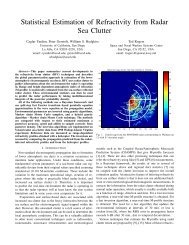Statistical Estimation and Tracking of Refractivity from Radar Clutter
Statistical Estimation and Tracking of Refractivity from Radar Clutter
Statistical Estimation and Tracking of Refractivity from Radar Clutter
Create successful ePaper yourself
Turn your PDF publications into a flip-book with our unique Google optimized e-Paper software.
ABSTRACT OF THE DISSERTATION<br />
<strong>Statistical</strong> <strong>Estimation</strong> <strong>and</strong> <strong>Tracking</strong> <strong>of</strong> <strong>Refractivity</strong> <strong>from</strong> <strong>Radar</strong> <strong>Clutter</strong><br />
by<br />
Caglar Yardim<br />
Doctor <strong>of</strong> Philosophy in Electrical Engineering<br />
(Applied Ocean Sciences)<br />
University <strong>of</strong> California, San Diego, 2007<br />
William S. Hodgkiss, Chair<br />
Kenneth Kreutz-Delgado, Co-Chair<br />
In many maritime regions <strong>of</strong> the world, such as the Mediterranean, Persian<br />
Gulf, East China Sea, <strong>and</strong> the Californian Coast, atmospheric ducts are common<br />
occurrences. They result in various anomalies such as significant variations<br />
in the maximum operational radar range, creation <strong>of</strong> regions where the radar is<br />
practically blind (radar holes) <strong>and</strong> increased sea clutter. Therefore, it is important<br />
to predict the real-time 3-D environment in which the radar is operating so that<br />
the radar operator will at least know the true system limitations <strong>and</strong> in some cases<br />
even compensate for them.<br />
This dissertation addresses the estimation <strong>and</strong> tracking <strong>of</strong> the lower atmospheric<br />
radio refractivity under non-st<strong>and</strong>ard propagation conditions frequently<br />
encountered in low altitude maritime radar applications. This is done by statistically<br />
estimating the duct strength (range <strong>and</strong> height-dependent atmospheric index<br />
<strong>of</strong> refraction) <strong>from</strong> the sea-surface reflected radar clutter. Therefore, such methods<br />
are called <strong>Refractivity</strong> From <strong>Clutter</strong> (RFC) techniques. These environmental<br />
statistics can then be used to predict the radar performance. The electromagnetic<br />
propagation in these complex environments is simulated using a split-step<br />
fast Fourier transform (FFT) based parabolic equation (PE) approximation to the<br />
wave equation.<br />
xviii




